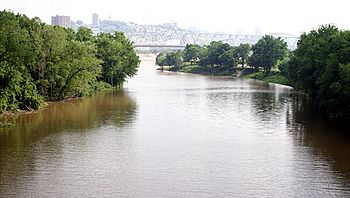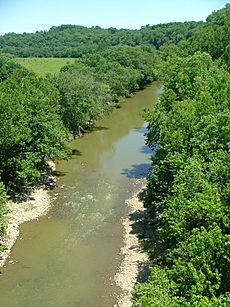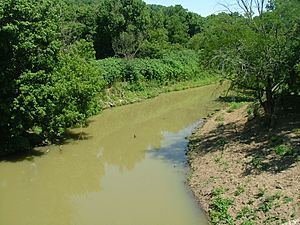Licking River (Kentucky) facts for kids
Quick facts for kids Licking River |
|
|---|---|

The mouth of the Licking River, where it joins the Ohio River
|
|
| Physical characteristics | |
| Main source | Magoffin County, Kentucky |
| River mouth | Ohio River |
| Length | 303 miles (488 km) |
| Basin features | |
| Basin size | 3,697 sq mi (9,580 km2) |
The Licking River is a long river in northeastern Kentucky, United States. It flows for about 303 miles (488 km). This river is a major branch of the Ohio River. The Licking River and its smaller streams drain a large area of northeastern Kentucky. This area is between the Kentucky River to the west and the Big Sandy River to the east. The North Fork Licking River is one of its important branches.
Contents
What's in a Name? The Licking River's Story

Long ago, Native Americans living in the area called this river Nepernine. In 1750, an explorer named Thomas Walker saw the river. He decided to call it Frederick's River.
Before that, hunters and frontiersmen had another name for it: Great Salt Lick Creek. This name came from the many salty springs near the river. Animals would come to these salt licks to get salt. The current name, Licking River, probably came from this older name.
A Look Back: History of the Licking River
For thousands of years, many Native American tribes lived near the Licking River. Tribes like the Shawnee and Cherokee often hunted in this valley. There were also older settlements in Bath County along Slate Creek.
The river was a very important way to travel and trade. Native Americans used it, and later, European settlers did too. These settlers started moving into the area in the mid-1700s.
During the Revolutionary War in 1780, American frontiersmen gathered at the river's mouth. They were led by George Rogers Clark. They marched up the Little Miami River valley. There, they fought against British outposts and Native American tribes. These tribes included parts of the Shawnee, Miami, Mingo, and Delaware.
In 1782, a famous battle called the Battle of Blue Licks happened here. Later, from 1803 to 1894, the Newport Barracks in Newport guarded the river's mouth.
Today, the Licking River is a great place for fun activities. People enjoy boating, canoeing, and fishing. The Cincinnati Junior Rowing Club also uses the river for rowing practice.
Where the River Flows: Its Course
The Licking River starts in the Cumberland Plateau in eastern Kentucky. It begins in southeastern Magoffin County. It forms where two smaller streams meet.
The river then flows northwest in a winding path. It goes past towns like Salyersville and West Liberty. In Rowan County, inside the Daniel Boone National Forest, the river forms a large lake. This lake is called Cave Run Lake.
After the lake, the river flows across the Bluegrass region of northern Kentucky. It meets the Fleming Creek about 8 miles (13 km) northwest of Carlisle. It also gets water from the North Fork and South Fork. The North Fork joins near Mount Olivet. The South Fork joins at Falmouth.
Finally, the Licking River joins the Ohio River. This happens across from Cincinnati. At this point, the Licking River separates the cities of Covington and Newport. The river also forms borders for several counties, like Mason, Fleming, and Rowan counties.
Amazing Animals and Plants: Life in the Licking River

Scientists who study nature, called ecologists, think this river has a very special ecosystem. An ecosystem is a community of living things and their environment.
The lower part of the river is home to a rare fish called the native muskellunge. Many other fish species live in the river basin. These include the redside dace, mimic shiner, and blue sucker.
The river also has more than 50 types of freshwater mussels. Sadly, 11 of these mussel species are endangered. This means they are at risk of disappearing forever.
The river's watershed is also a vital stopover for birds. About 250 species of migratory birds use this area. This is a very high number of bird species!
Many groups are working to protect this important habitat. State and federal agencies, along with private groups like The Nature Conservancy, help keep the river healthy.
Did you know? The biggest common carp ever caught in Kentucky was found here. It weighed over 54 pounds (24.5 kg)! It was caught in the South Fork of the Licking River.


